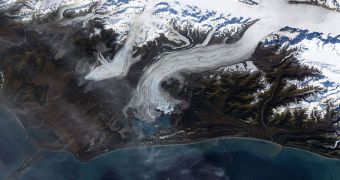The conclusions of the most recent scientific investigation conducted on glaciers in Alaska show that ices in this area are melting down just like they are in Antarctica, Greenland and the rest of the Arctic.
Studies conducted as far back as the 1980s demonstrated without a doubt that the massive glaciers on the Alaska Peninsula were key players in controlling global sea levels and traits such as ocean salinity.
However, due to limited technological means, experts did not have a method of analyzing these ice fields in close details, so as to be able to determine whether the glaciers were melting or not with any degree of certainty.
Recently, investigators led by University of Alaska Fairbanks (UAF) Geophysical Institute assistant research professor Dr. Anthony Arendt managed to surpass previous limitations, and establish for sure that these majestic glaciers are indeed melting.
The scientist and his team say that more studies are needed to understand the dynamics of these glaciers. At other ice fields around the world, experts have been conducting studies for years, and therefore have a good idea of how the structures evolve over time.
This is not the case for Alaska, and this is why longer-term monitoring is in order. At the same time, studies are made all the more difficult by the fact that numerous types of glaciers occupy the land.
“Alaska has quite a lot of different types of glaciers that it's hard to choose one that is representative. You don't get such a variety in other places,” Dr. Arendt tells Our Amazing Planet.
The expert is also the author of a new study detailing the findings, which is published in this week's issue of the top journal Science. Overall, he underlines, Alaskan glaciers are indeed losing mass.
“Field observations are challenging to do twice a year, and we're restricted to glaciers that are safe,” the investigator says of some of the challenges associated with conducting glacier research in Alaska.
Yet, doing so is vital, say other experts. The Peninsula contains vast amounts of ice, exceeded only by Greenland and the Antarctica. If all the glaciers in Alaska melt, then global sea levels would increase by several feet, bringing about widespread floods, and wiping out island nations in the oceans.
“We have some really remarkable new technologies, but one of the surprising things we have learned from remote measurements is just how complex these systems are,” Arendt says. “We need to study individual glaciers and how they're changing, and also to combine techniques and collaborate with other research groups,” he concludes.

 14 DAY TRIAL //
14 DAY TRIAL //